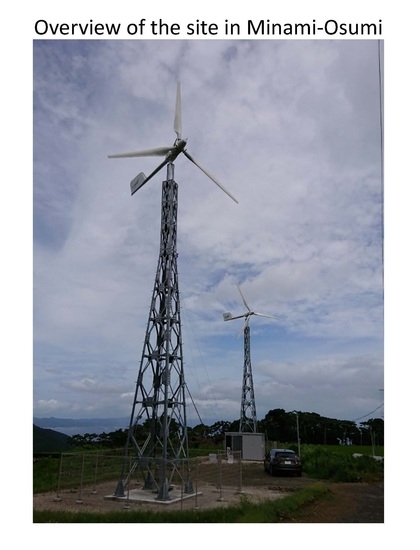An Evaluation of Flicker Emissions from Small Wind Turbines
Abstract
:1. Introduction
2. Principle of Voltage Variation and Flicker Emission
2.1. Voltage Variation Caused by SWTs
2.2. Evaluation Methodology of Flicker Emissions
- •
- instead of was used for the evaluation of flicker emissions in the Japanese Grid Interconnection Code [8] (p. 265).
- •
- The value is evaluated at 1 min intervals. This shorter evaluation interval appears to be better at capturing the impact of individual output power variation on the flicker emissions from SWTs, as wind conditions often change within a short period of time.
3. Small Wind Power Facility and Measurement Arrangement at the Site in Minami-Osumi
4. Evaluation of Flicker Emissions at the Site in Minami-Osumi
4.1. Thevenin Equivalent Resistance
4.2. Flicker Emission and Total Output Power
4.3. Power Spectra and Data Extraction
- Voltage variation largely caused not by the SWTs but other factors, as in the case of Figure 7b.
- Errors in the time-series data. In particular, the signal-to-noise ratio of the data is lower than that of the data, because the variation in the is only 1% (a few volts over a nominal voltage of 200 V).
4.4. Analysis of Flicker Emissions from SWTs
4.5. Coherence
4.6. Turbulence Intensity
5. Re-Evaluation of the Results from the Site in Wakkanai
- Increments were used for the estimation of the Thevenin equivalent resistance, as described in Section 4.1.
- Valid data were extracted while focusing on the ratio as described in Section 4.3.
5.1. Thevenin Equivalent Resistance
5.2. Flicker Emission and Total Output Power
5.3. Power Spectra
5.4. Comparison of Flicker Emission
6. Conclusions
- The flicker emission solely caused by variable-speed SWTs with a total power rating of 20 kW was significantly lower than the upper limit at the two sites. Even if the total power rating was increased until 50 kW, which is the maximum capacity to be connected with low-voltage distribution systems in Japan, it was estimated that the flicker emission was lower than the tolerable limit. One reason for this is that the Thevenin equivalent resistance of the grids was as low as 0.023 Ω. Another reason may be that the inertia of the rotational parts, such as the wind turbine rotor and generator rotor, created a smoother output power fluctuation against the mechanical input fluctuations caused by the wind speed variation.
- The flicker emission was at its highest when the mean total output power was approximately 3/4 of the total power rating of small wind power facilities.
- It was beneficial to use the ratio of high-frequency components in the PCC voltage and total output power to extract valid flicker emission data from all the measured data, though this methodology was not available if the PCC voltage fluctuation caused not by the SWTs but other factors was always high.
Author Contributions
Funding
Acknowledgments
Conflicts of Interest
References
- Li, Y.; Gao, W.; Ruan, Y. Quantifying variabilities and impacts of massive photovoltaic integration in public power systems with PHS based on real measured data of Kyushu, Japan. Energy Procedia 2018, 152, 883–888. [Google Scholar] [CrossRef]
- International Electrotechnical Commission (IEC). Wind Turbines—Part 2: Small Wind Turbines, 3rd ed.; IEC 61400-2; IEC: Geneva, Switzerland, 2013. [Google Scholar]
- Agency for Natural Resources and Energy. FIT Information Disclosure Website. Available online: https://www.fit-portal.go.jp/PublicInfoSummary (accessed on 10 June 2021). (In Japanese).
- Matsuda, K.; Wada, M.; Furukawa, T.; Watanabe, M.; Takahashi, R. Measurement results for evaluation of impact on power system by small wind turbines. In Proceedings of the 2007 Tohoku Section Joint Convention of Institutes of Electrical and Information Engineers, Aomori, Japan, 23–24 August 2007; 2B22; p. 82. (In Japanese). [Google Scholar]
- Chalise, S.; Atia, H.R.; Poudel, B.; Tonkoski, R. Impact of Active Power Curtailment of Wind Turbines Connected to Residential Feeders for Overvoltage Prevention. IEEE Trans. Sustain. Energy 2015, 7, 471–479. [Google Scholar] [CrossRef]
- Larsson, A. Flicker emission of wind turbines during continuous operation. IEEE Trans. Energy Convers. 2002, 17, 114–118. [Google Scholar] [CrossRef]
- Larsson, Å.; Sørensen, P.; Santjer, F. Grid Impact of Variable-Speed Wind Turbines. In Proceedings of the European Wind Energy Conference (EWEC), Nice, France, 1–5 March 1999; pp. 786–789. [Google Scholar]
- The Japan Electric Association. Grid-Interconnection Code. In JEAC 9701-2019; The Japan Electric Association: Tokyo, Japan, 2019. (In Japanese) [Google Scholar]
- Thiringer, T.; Petru, T.; Lundberg, S. Flicker Contribution From Wind Turbine Installations. IEEE Trans. Energy Convers. 2004, 19, 157–163. [Google Scholar] [CrossRef]
- Kondoh, J.; Mizuno, H.; Funamoto, T. Fault Ride-Through Characteristics of Small Wind Turbines. Energies 2019, 12, 4587. [Google Scholar] [CrossRef] [Green Version]
- Liu, Y.J.; Chen, Y.C.; Lan, P.H.; Chang, T.P. Power Quality Measurements of a Horizontal Axial Small Wind Turbine. Appl. Mech. Mater. 2017, 870, 329–334. [Google Scholar] [CrossRef]
- Liu, Y.-J.; Lan, P.-H. Power Quality Assessments of a Commercial Grid-Connected Small Wind Turbine Product. In Proceedings of the 2016 IEEE 5th Global Conference on Consumer Electronics, Kyoto, Japan, 11–14 October 2016; pp. 1–4. [Google Scholar] [CrossRef]
- Mohammadi, E.; Fadaeinedjad, R.; Naji, H.R. Flicker emission, voltage fluctuations, and mechanical loads for small-scale stall- and yaw-controlled wind turbines. Energy Convers. Manag. 2018, 165, 567–577. [Google Scholar] [CrossRef]
- Long, C.; Farrag, M.E.A.; Zhou, C.; Hepburn, D.M. Statistical Quantification of Voltage Violations in Distribution Networks Penetrated by Small Wind Turbines and Battery Electric Vehicles. IEEE Trans. Power Syst. 2013, 28, 2403–2411. [Google Scholar] [CrossRef]
- Ani, S.O.; Polinder, H.; Ferreira, J.A. Comparison of Energy Yield of Small Wind Turbines in Low Wind Speed Areas. IEEE Trans. Sustain. Energy 2012, 4, 42–49. [Google Scholar] [CrossRef]
- Pagnini, L.C.; Burlando, M.; Repetto, M.P. Experimental power curve of small-size wind turbines in turbulent urban environment. Appl. Energy 2015, 154, 112–121. [Google Scholar] [CrossRef]
- Kashiwaya, K.; Kondoh, J.; Funabashi, K. Total output power variation of several small wind turbines. Wind. Eng. 2020, 45, 518–537. [Google Scholar] [CrossRef]
- International Electrotechnical Commission (IEC). Electromagnetic Compatibility (EMC)—Part 4: Testing and Measurement Techniques—Section 15: Flicker-Meter—Functional and Design Specifications, 2nd ed.; IEC 61000-4-15; IEC: Geneva, Switzerland, 2010. [Google Scholar]
- Novitskiy, A.; Schau, H. Relationship between the Flicker Criteria V10 and Pst. In Proceedings of the 2012 IEEE 15th International Conference on Harmonics and Quality of Power, Hong Kong, China, 17–20 June 2012; pp. 803–808. [Google Scholar] [CrossRef]
- Yamada, K.; Mitsutsuji, J. Factor and Measure in Voltage Flicker. J. Inst. Electr. Install. Eng. Jpn. 2005, 25, 776–780. (In Japanese) [Google Scholar]
- International Electrotechnical Commission (IEC). Wind Energy Generation Systems—Part 21-1: Measurement and Assessment of Electrical Characteristics—Wind Turbines, IEC 61400-21-1, 1st ed.; IEC: Geneva, Switzerland, 2019. [Google Scholar]
- Redondo, K.; Gutiérrez, J.J.; Azcarate, I.; Saiz, P.; Leturiondo, L.A.; De Gauna, S.R. Experimental Study of the Summation of Flicker Caused by Wind Turbines. Energies 2019, 12, 2404. [Google Scholar] [CrossRef] [Green Version]
- Sørensen, P.; Gerdes, G.; Klosse, R.; Santjer, F.; Robertson, N.; Davy, W.; Koulouvari, M.; Morfiadakis, E.; Larsson, Å. Standards for Measurements and Testing of Wind Turbine Power Quality. In Proceedings of the European Wind Energy Conference (EWEC), Nice, France, 1–5 March 1999; pp. 721–724. [Google Scholar]
- Tamura, S.; Kondoh, J.; Kushida, Y. Influence of voltage measurement accuracy on the impedance estimation by a power conditioning system. In Proceedings of the 4th International Conference on Smart Grid and Smart Cities (ICSGSC), Osaka, Japan, 18–21 August 2020; pp. 44–49. [Google Scholar] [CrossRef]
- Japan Electrical Safety & Environment Technology Laboratories. General Rules on Test Method of Grid-Connected Protective Equipment etc. for Small-Scale Dispersed Power Generating Systems, JET GR 0002-1-7.0; Japan Electrical Safety & Environment Technology Laboratories: Tokyo, Japan, 2016. (In Japanese) [Google Scholar]
- Nanahara, T.; Asari, M.; Sato, T.; Yamaguchi, K.; Shibata, M.; Maejima, T. Smoothing effects of distributed wind turbines. Part 1. Coherence and smoothing effects at a wind farm. Wind. Energy 2004, 7, 61–74. [Google Scholar] [CrossRef]
- Central Research Institute of Electric Power Industry (CRIEPI). Investigation on Stabilization of Wind Power and Power Systems. In Investigation Report of the New Energy and Industrial Technology Development (NEDO) 2002; NEDO: Kanagawa, Japan, 2002; pp. 688–699. (In Japanese) [Google Scholar]
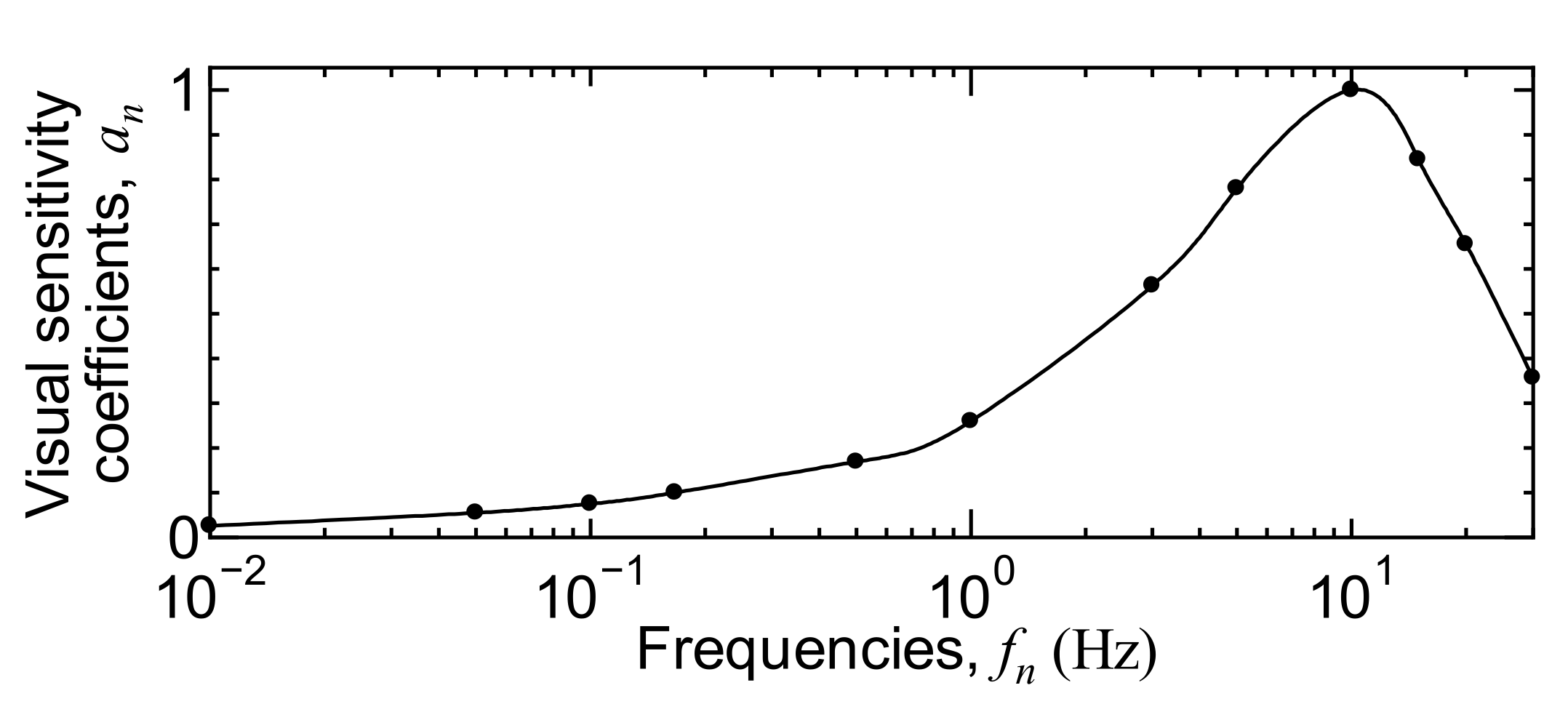
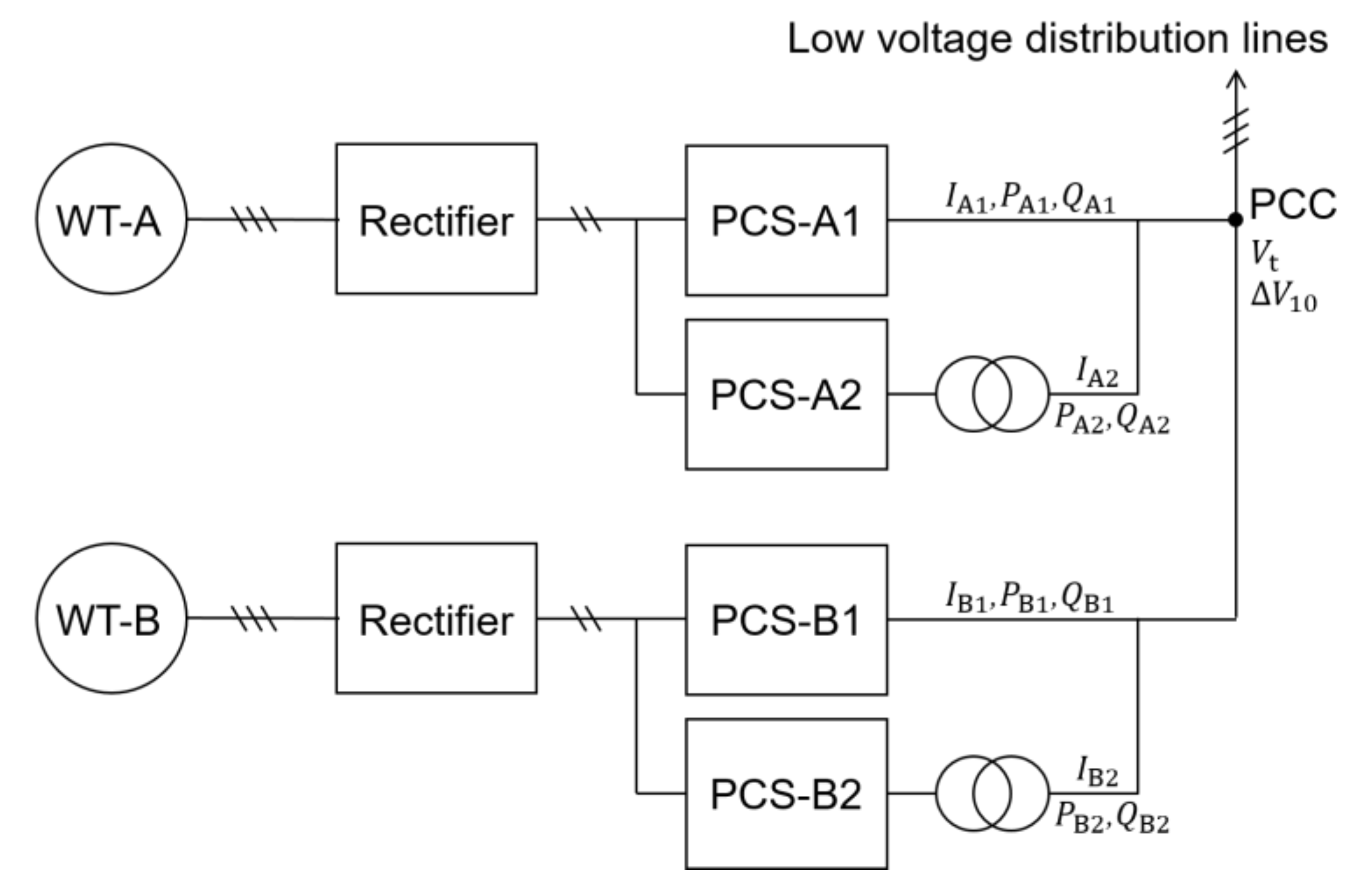
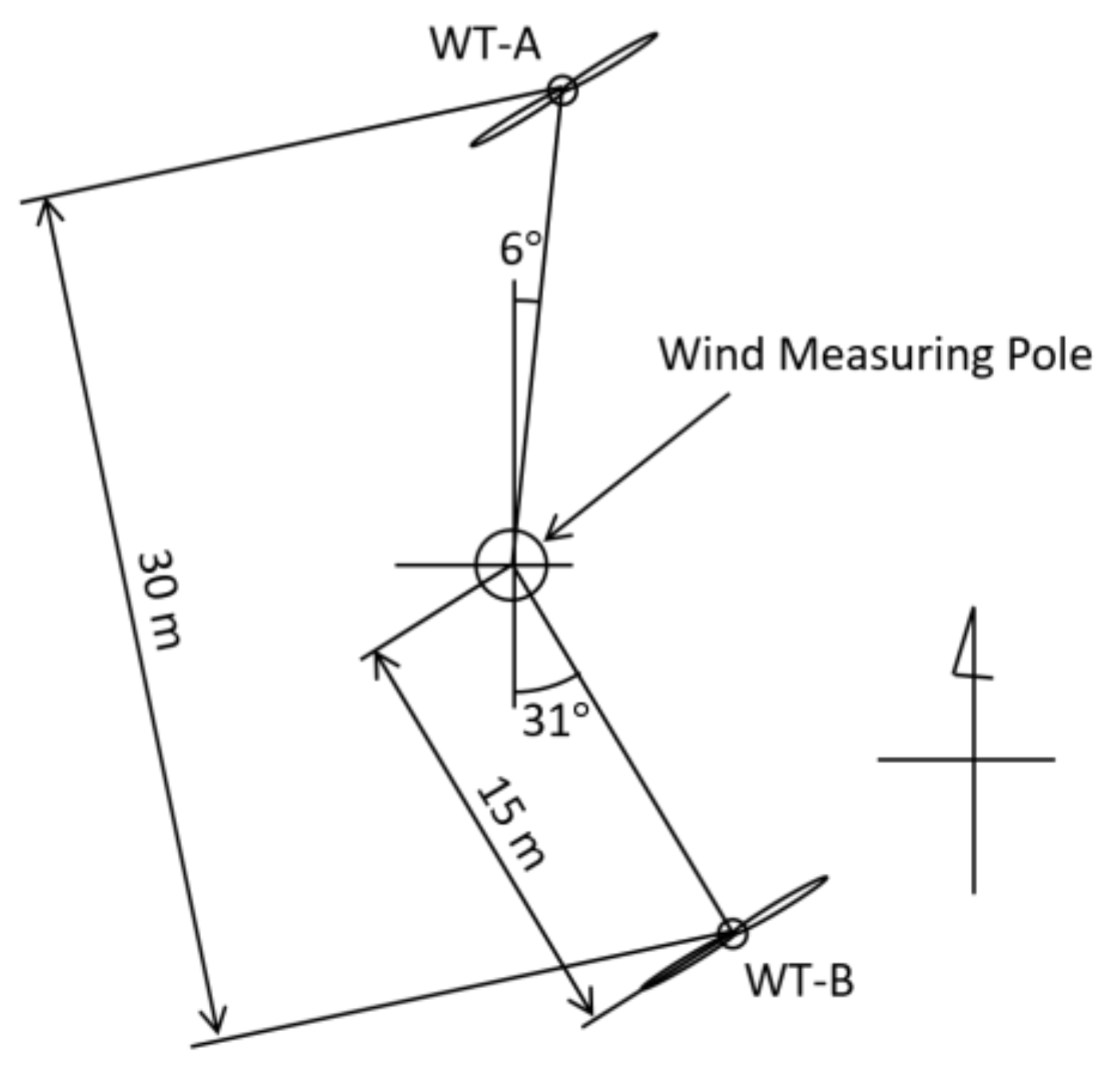
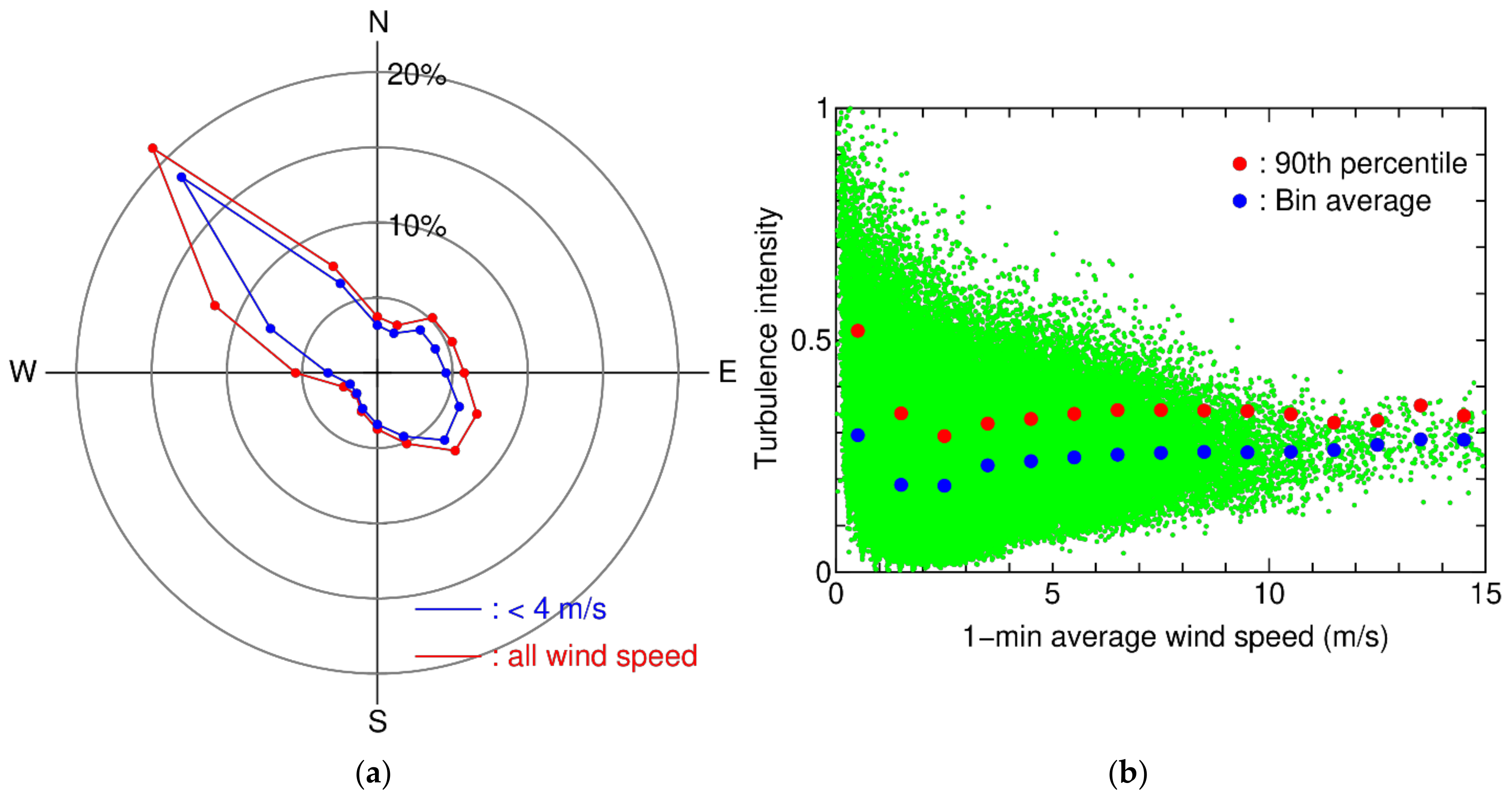

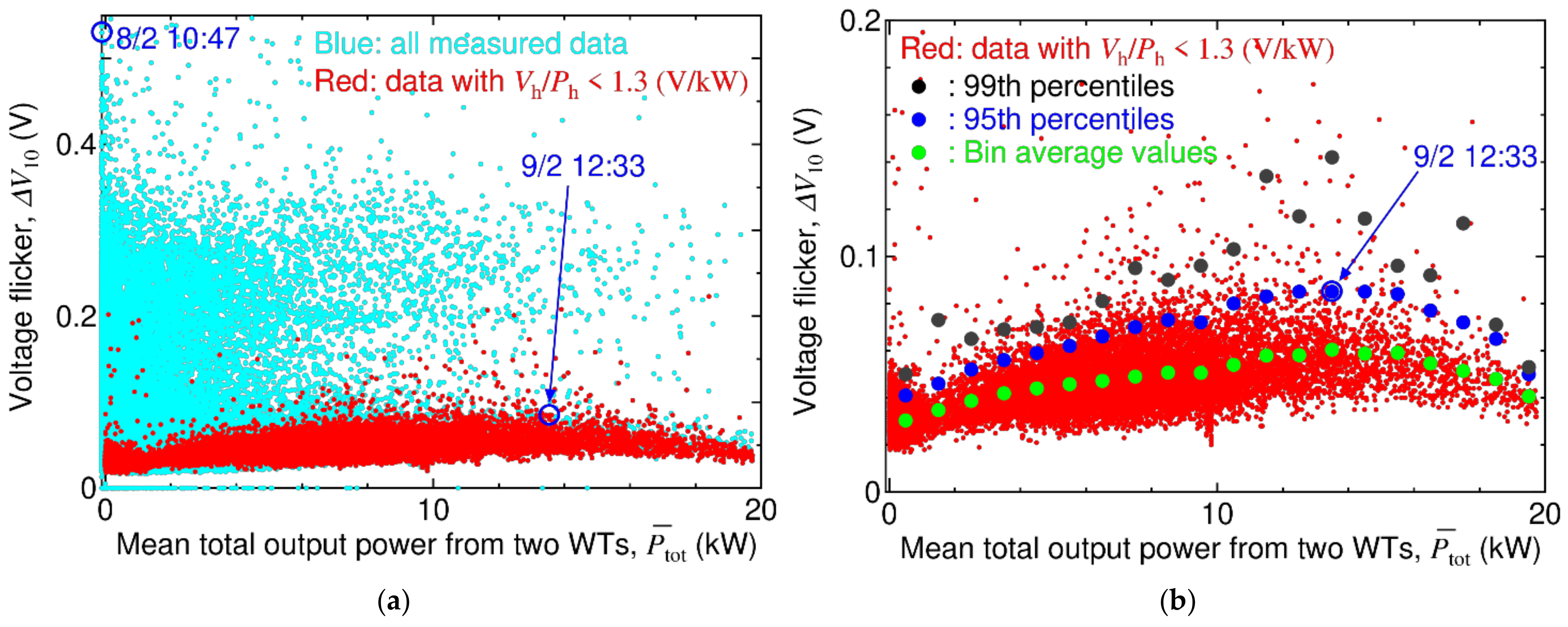
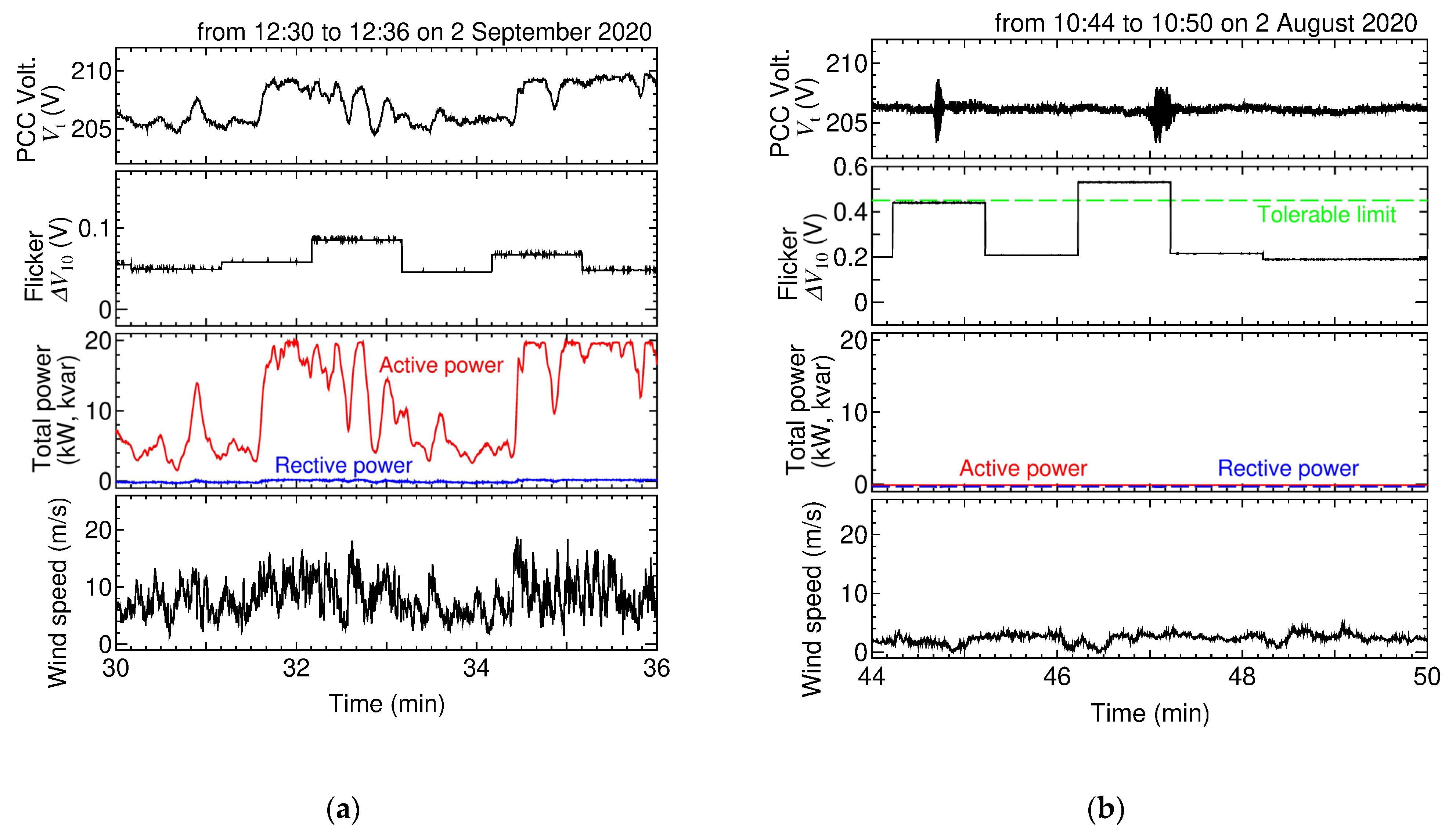
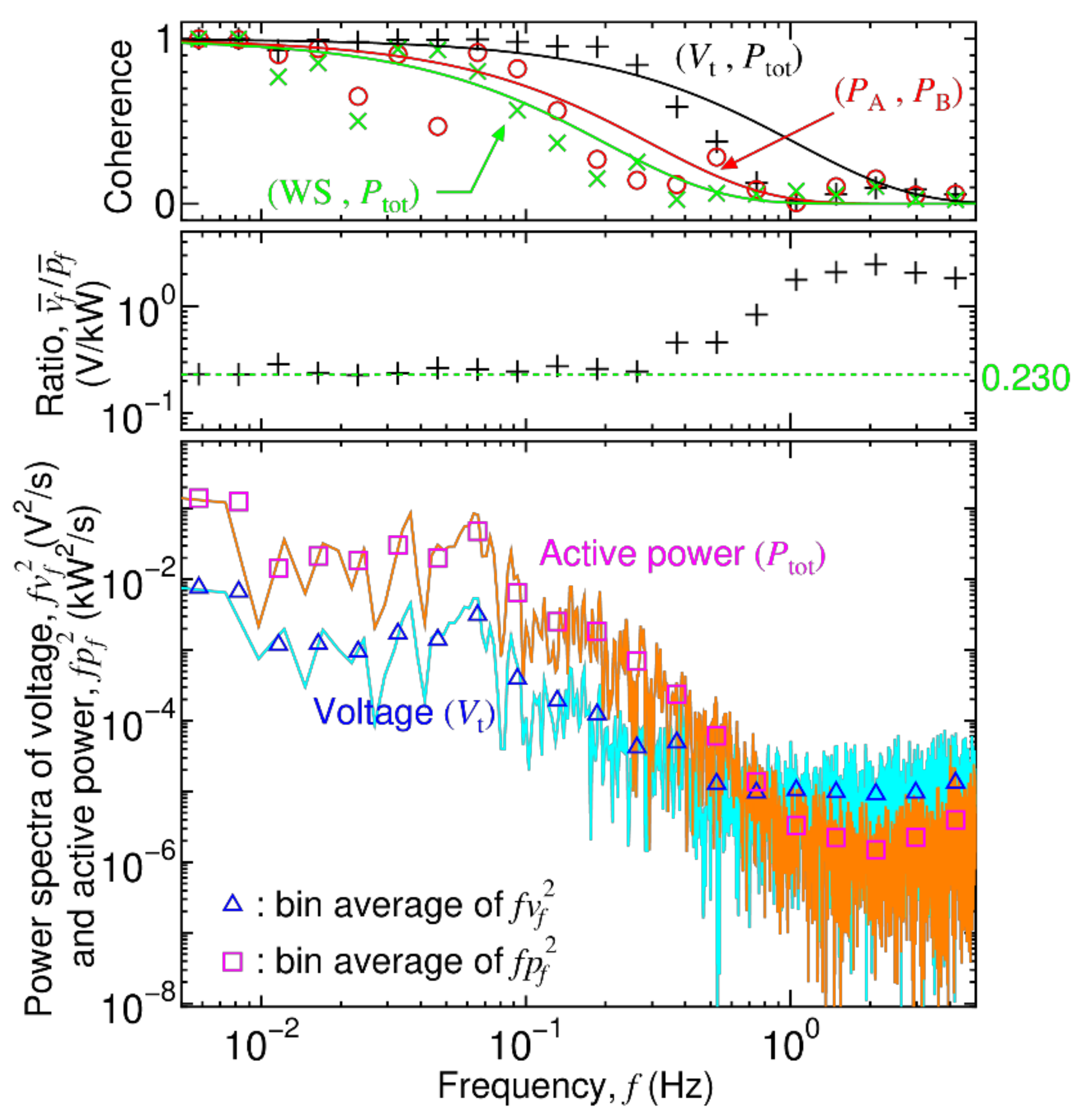
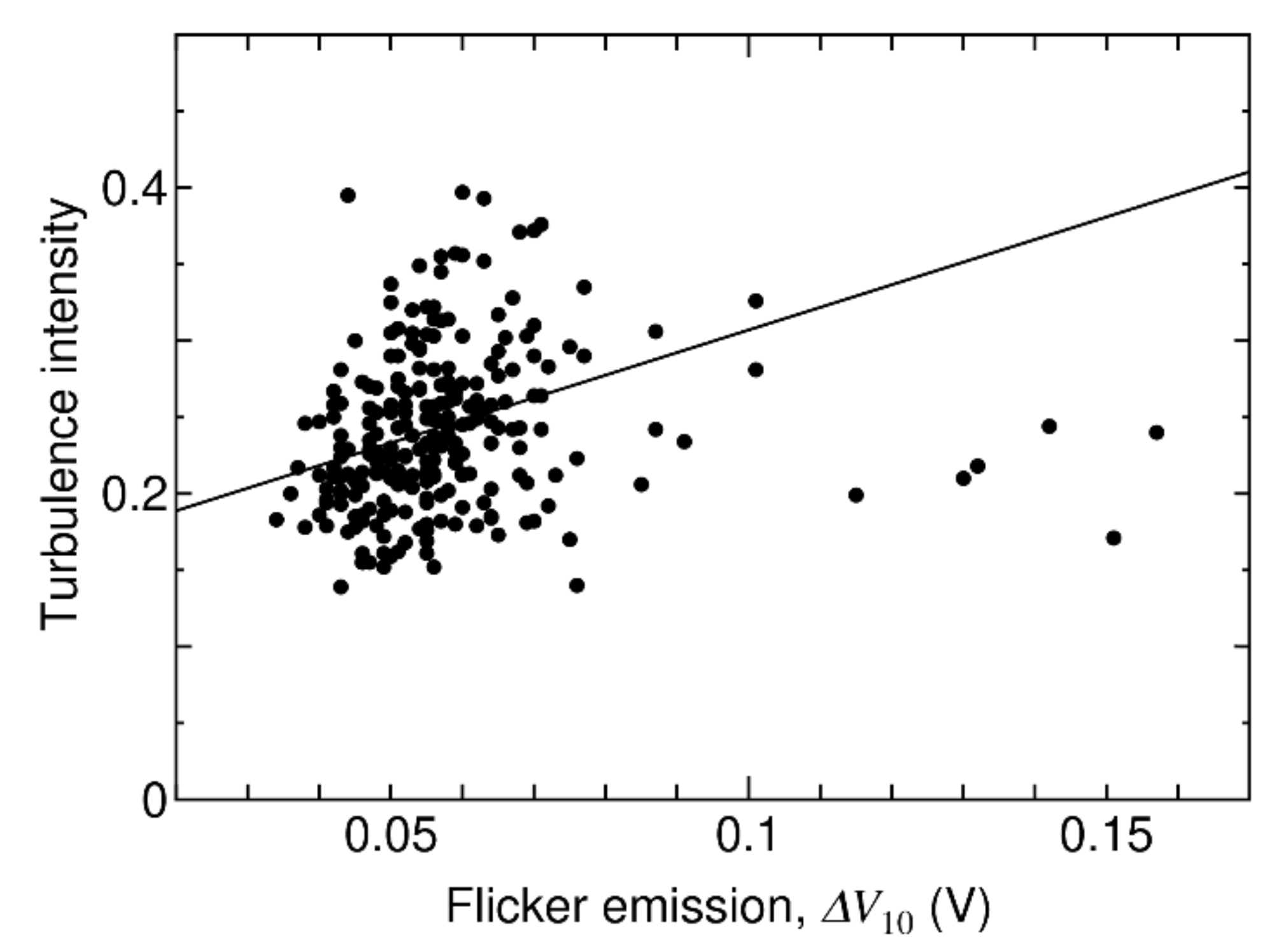
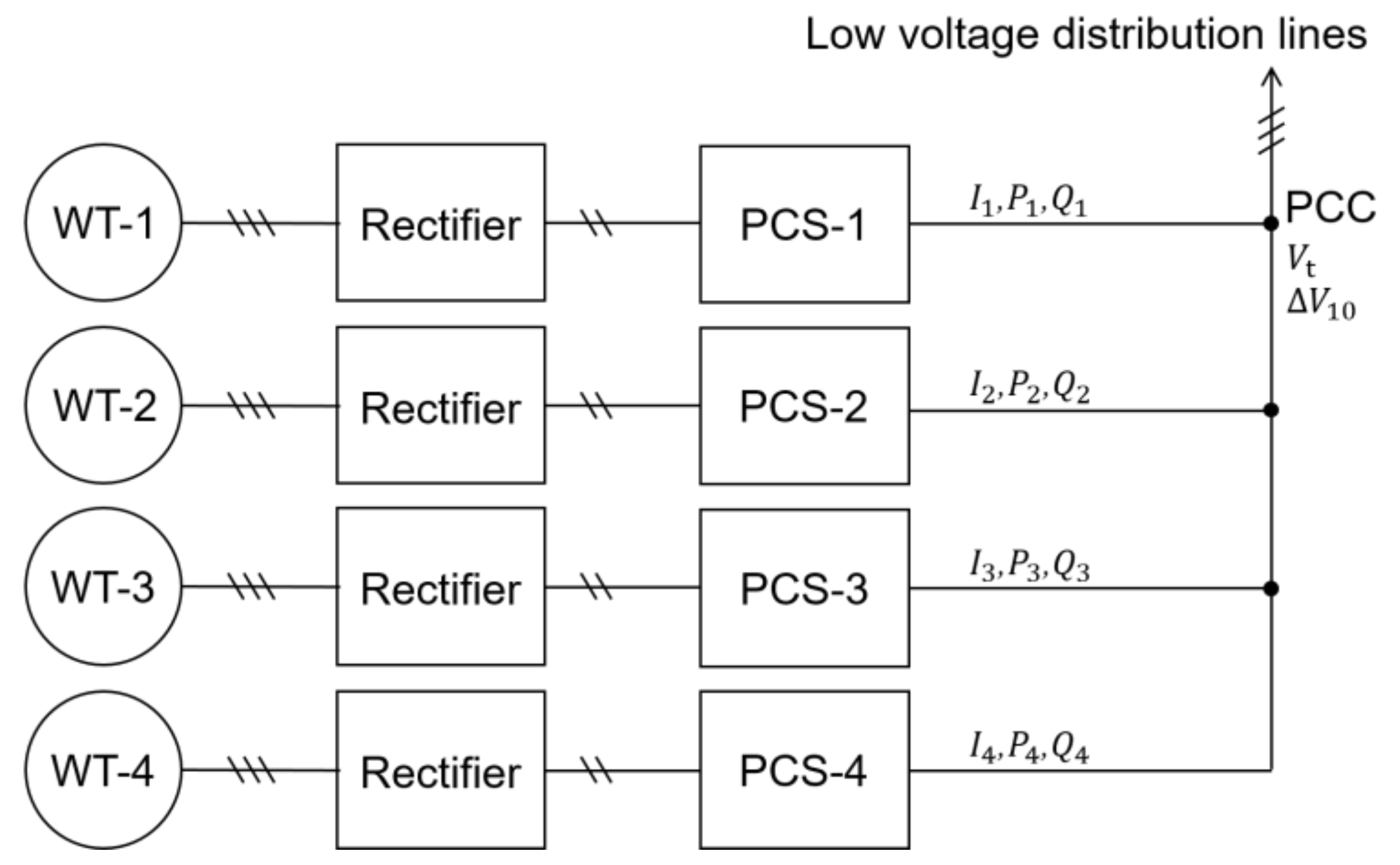

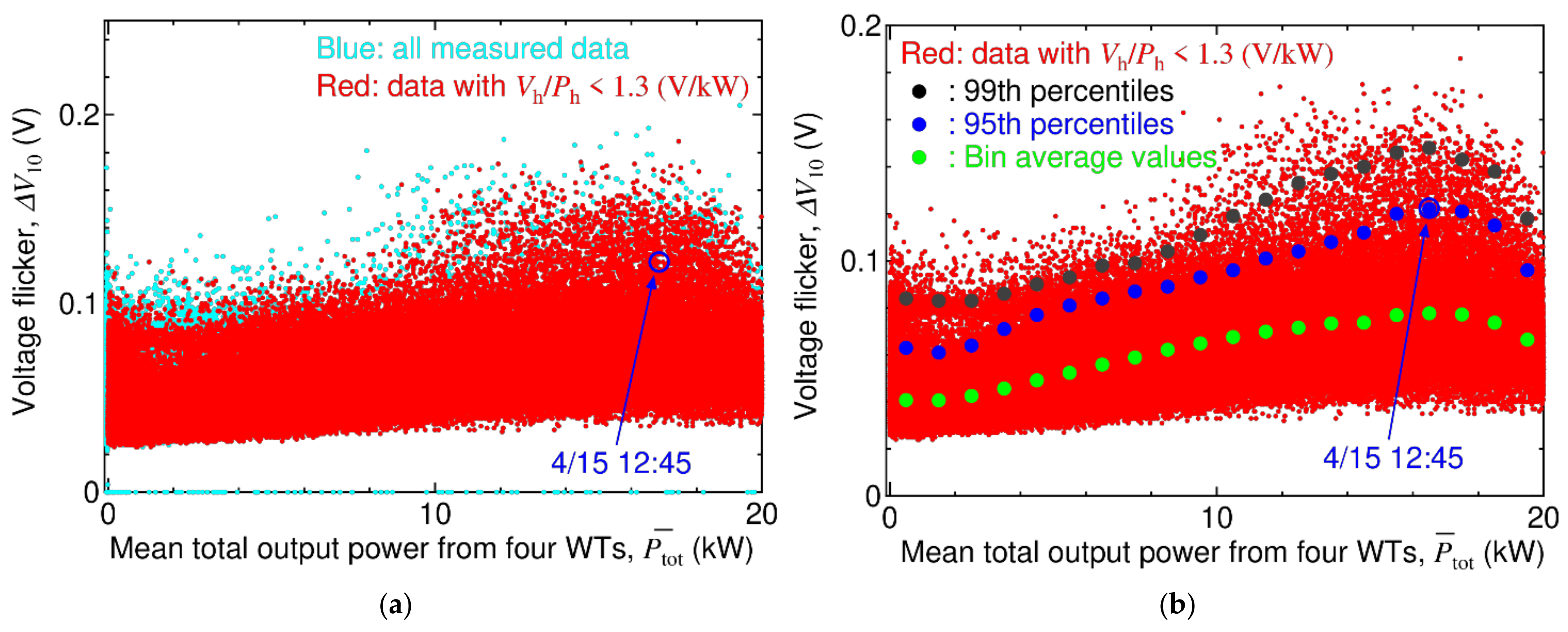

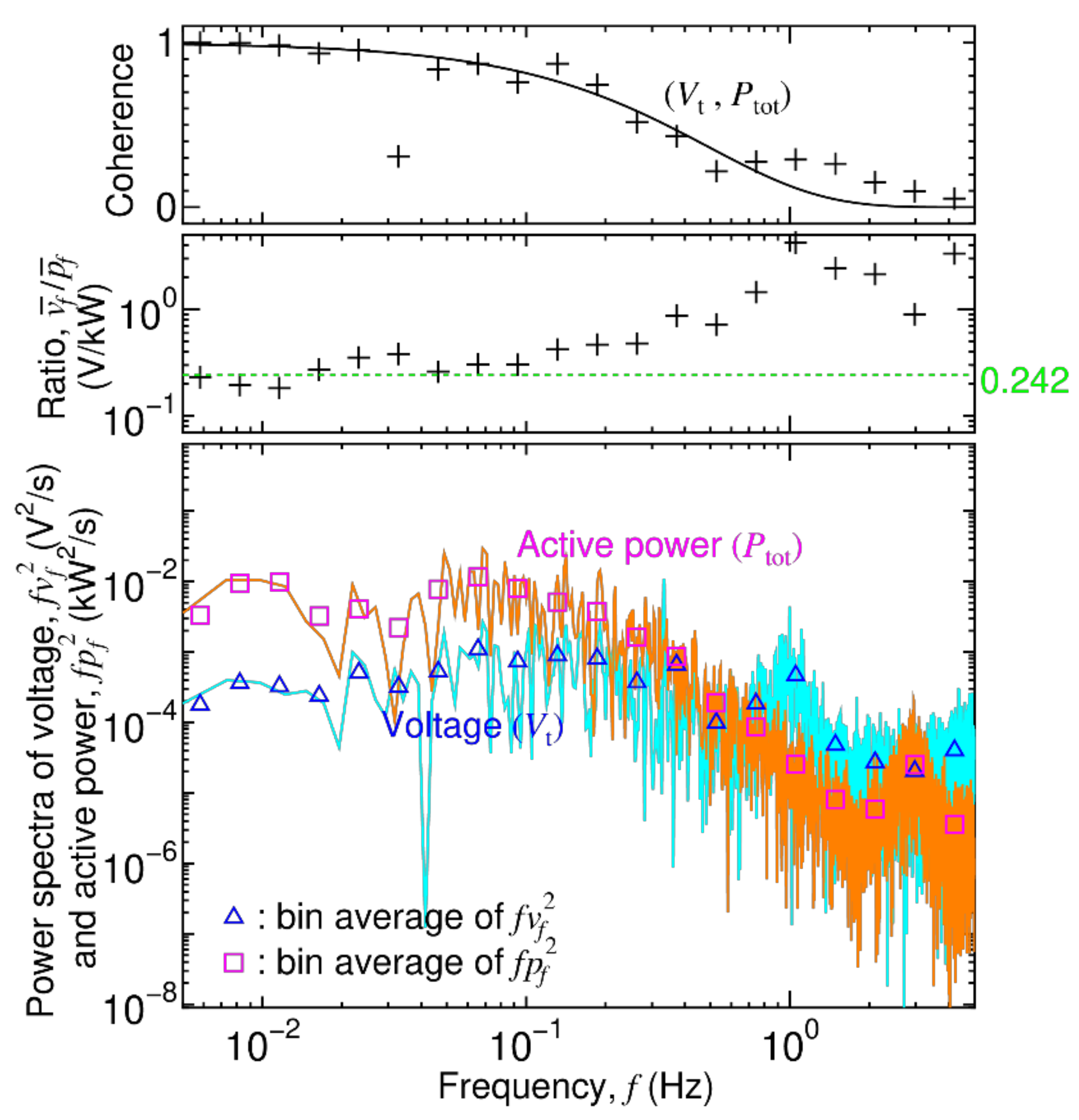
| Model | ANE AH—10 kW |
| Rated power (at 11 m/s) | 10 kW |
| Rotor diameter | 7.8 m |
| Number of blades | 3 |
| Working wind speed | 3–25 m/s |
| Rated rotor speed | 180 rpm |
| Model | Zephyr 9000 |
| Rated power (continuous max) | 4.9 kW |
| Rotor diameter | 5.5 m |
| Number of blades | 3 |
| Cut-in wind speed | 3.5 m/s |
| Rated rotor speed | 277 rpm |
Publisher’s Note: MDPI stays neutral with regard to jurisdictional claims in published maps and institutional affiliations. |
© 2021 by the authors. Licensee MDPI, Basel, Switzerland. This article is an open access article distributed under the terms and conditions of the Creative Commons Attribution (CC BY) license (https://creativecommons.org/licenses/by/4.0/).
Share and Cite
Kondoh, J.; Kodaira, D. An Evaluation of Flicker Emissions from Small Wind Turbines. Energies 2021, 14, 7263. https://doi.org/10.3390/en14217263
Kondoh J, Kodaira D. An Evaluation of Flicker Emissions from Small Wind Turbines. Energies. 2021; 14(21):7263. https://doi.org/10.3390/en14217263
Chicago/Turabian StyleKondoh, Junji, and Daisuke Kodaira. 2021. "An Evaluation of Flicker Emissions from Small Wind Turbines" Energies 14, no. 21: 7263. https://doi.org/10.3390/en14217263
APA StyleKondoh, J., & Kodaira, D. (2021). An Evaluation of Flicker Emissions from Small Wind Turbines. Energies, 14(21), 7263. https://doi.org/10.3390/en14217263





